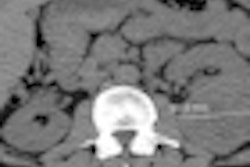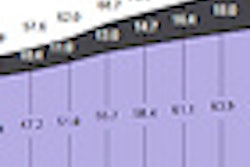Are last month's guidelines on CT lung screening too conservative? That's the contention of a number of CT screening advocates, who believe that restricting the technology to high-risk individuals means thousands of current and former smokers could die of advanced disease that could have been detected earlier.
In the May 20 edition of the Journal of the American Medical Association, the American College of Chest Physicians (ACCP) and several other medical societies issued guidelines that call for low-dose CT screening of individuals ages 55 to 74 with smoking histories of 30 pack-years or more. The groups said that their analysis of the literature could not find clear-cut evidence that CT screening's benefits outweigh the harms in lower-risk individuals.
But screening advocates are attacking the report's conclusions, charging that its narrowly targeted population shows a bias against lung cancer screening. The supporters believe the screening criteria are too strict, and that studies were selectively picked to downplay the benefits of screening.
Long-overdue guidelines
"I think it's a good thing that we finally after 20 years have a guideline [stating] that high-risk people should be screened for lung cancer, but I think the multigroup process that produced the paper in JAMA was very badly done -- and I think it was deliberately done badly in order to weaken the recommendation," Dr. Frederic Grannis, clinical professor of thoracic surgery at City of Hope National Medical Center in Duarte, CA, told AuntMinnie.com in a telephone interview.
The guidelines didn't have to be so narrow, he said. Lung screening guidelines issued last fall by the National Comprehensive Cancer Network (NCCN) were much broader, giving a strong level 1 recommendation for screening of high-risk individuals with 30 or more pack-years of smoking history, while still offering a weaker 2B recommendation for smokers with 20 or more pack-years of smoking history, plus a second risk factor such as family history of lung cancer or a diagnosis of chronic obstructive pulmonary disease.
The NCCN guidelines didn't garner half the attention of the JAMA paper, but they were based on a much wider review of the evidence, Grannis said.
On the other hand, the ACCP guidelines, rather than examining a broad base of research on which to base recommendations, were "deliberately restricted to cut out most of the evidence we have on lung cancer screening," with important studies "censored from being used to help craft the guidelines," Grannis said.
According to Grannis, the recent JAMA analysis conspicuously left out data from the International Early Lung Cancer Action Project (I-ELCAP) series of studies -- which has grown since the mid-1990s to encompass 74 screening centers worldwide and about 60,000 subjects. The JAMA paper did include the original ELCAP study of the baseline screening findings in 1,000 patients published in the Lancet (July 10, 1999, Vol. 354:9173, pp. 99-105).
Publication of the first large I-ELCAP trial, which screened more than 31,000 patients to find 484 cases of lung cancer (New England Journal of Medicine, November 26, 2006, Vol. 355, pp. 1763-1711), made a big media splash with its finding that 85% (n = 412) of cancer cases had stage I cancer, and individuals who were screened had an estimated 10-year survival rate of 88%. But the results were controversial from the start, with critics decrying its lack of a control group, lack of an unbiased outcome measure, and failure to address the potential harms of screening.
But skipping I-ELCAP in the JAMA analysis was unfortunate in Grannis' view. I-ELCAP was not only large and well-performed, it demonstrated that nearly all cancers are detected at stage I, when curative success rate is the highest. The preponderance of early-stage cancers can only be good news for the practice of screening, I-ELCAP supporters maintain, because it means that screening detects nearly all cancers in time to effect a curative resection.
I-ELCAP supporters also note that screening harms have been shown to be so low as to be practically negligible, and maintaining a control group of high-risk smokers who do not get screened is unethical given CT's demonstrated high sensitivity for the detecting early-stage cancer.
In any case, I-ELCAP's screening experience in more than 60,000 smokers was excluded from the JAMA analysis. And, Grannis complained, the JAMA article and its lead author, Dr. Peter Bach, didn't say who chose the studies to include in the JAMA analysis, stating only that "an individual with experience in doing systematic reviews chose the method by which evaluations would be chosen."
A target for criticism?
As a result of the study, Bach has become something of a lightning rod for criticism in the proscreening community. He has made his negative view of the I-ELCAP series clear in many past statements, Grannis said, at one point dismissing its principal finding of 85% stage I cancers as an "outlier."
Indeed, I-ELCAP researcher Dr. Claudia Henschke from Mount Sinai School of Medicine wrote the Journal of the National Cancer Institute to defend her I-ELCAP results on January 24, 2012, complaining that Bach had criticized her study's conclusions unfairly by stating that proper consideration of the published findings "will require reconciling what in some cases appear to be contradictory, statistically unlikely, or outlier results."
Henschke charged that Bach "based his assertions on literature reviews that were selective and missing critically relevant particulars," adding that "his claim that I-ELCAP results are mutually inconsistent is wrong."
Bach's own analysis of eight studies found that screening has a high, 56% yield for early-stage cancers, Henschke said. "Dr. Bach excluded studies that he himself had included in his prior reviews with higher rates, some even higher than those reported by I-ELCAP," she said.
Bach has downplayed the benefits of lung cancer screening for years, Grannis charged, citing the researcher's results in a 2007 analysis of follow-up data on 3,246 smokers and ex-smokers screened at medical centers in the U.S. and Italy (JAMA, March 7, 2007). In that study, Bach et al found no evidence of a decline in the number of advanced lung cancers detected in the screening arm versus the number of expected cases or deaths from lung cancer following annual CT screening. For that 2007 analysis, Bach "cherry-picked three studies" to analyze, Grannis said.
"We don't see a trace of evidence that a single life was saved, that a single case of advanced cancer was avoided," Bach was quoted as saying in a May 31, 2009, USA Today article on lung cancer screening.
The latest analysis in JAMA included the National Lung Screening Trial (NLST) (NEJM, August 4, 2011, Vol. 365:5, pp. 395-409), but that study, despite its very positive results in showing a 20% mortality reduction from screening, was "not a great study" because unlike I-ELCAP it lacked a specific follow-up protocol for screen-detected lung nodules, Grannis said. He noted that it produced a very positive result by focusing on very high-risk individuals.
In fact, Bach's own lung cancer risk model shows a higher risk of developing lung cancer than last week's guidelines report, Grannis said. The Bach model (Chest, December 2004, Vol. 126:6, pp. 1742-1749) was developed to predict the absolute 10-year risk of developing lung cancer among smokers by use of participants in the Beta-Carotene and Retinol Efficacy Trial (CARET) for lung cancer prevention. The May 20 JAMA paper addresses the question of screening but does not assess cancer risk per se.
"Bach has been wrong consistently" on the benefits of screening, "yet the press continue to go to him for lung cancer screening information," Grannis said.
Bach declined to be interviewed for this article. He currently serves as an attending physician with a research focus on health outcomes, epidemiology, and biostatistics at Memorial Sloan-Kettering Cancer Center.
Those who advocate a conservative approach to screening would say the next step is a further randomized trial in a lower-risk group, but it would be "insane to participate in an unscreened arm of such a trial," Grannis said. "The bottom line is that a further study would take 10 years to get a result and during those 10 years a million more people will die of lung cancer. One hundred fifty-six thousand Americans die horribly from lung cancer every year, and they will continue to die unless we start screening them."
Tomorrow, in part 2: Who gets left out of lung cancer screening under the new guidelines, and who are CT screening's biggest enemies.



















